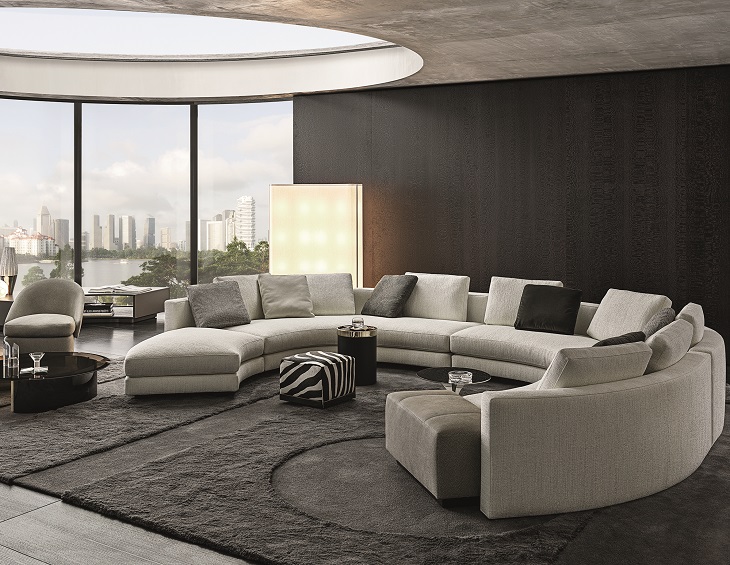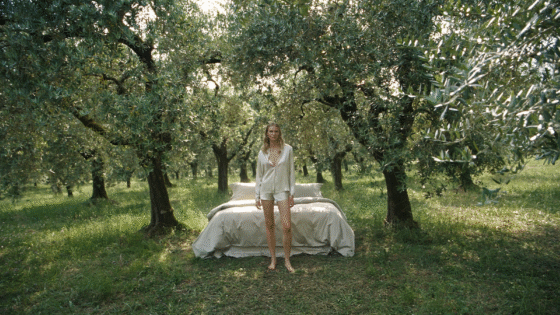During Milan Design Week’s Salone del Mobile, Minotti has finally lifted the lid on its highly anticipated 2019 indoor collection…
Hot off the heels of being at the centre of the action as the style partner for Meet Up London, Minotti has yet again raised the level of furniture design with the unveiling of its 2019 Collection during Milan Design Week.
Collection after collection, year after year, Minotti’s unquenchable passion can be sensed from all corners of the design-hub city.

For the 2019 Collection, the furniture company has conceived a new stylistic code, a new vision of the interior with surprising suggestions and atmospheres which play host to our new designs. Its intention is to provide food for thought in a surprising, creative, practical and dynamic way, to all those who choose our brand around the world.
The new collection, coordinated by Rodolfo Dordoni with Minotti Studio, brings a new vision of the living area to life, in which seating systems and furniture outline structured spaces and reveal new geometries in a continuous alternation of curves and straight lines. The result is a surprising variety of compositional solutions featuring unexpected combinations of textures and materials.
“Our partnership with designers with strong identities rooted in different cultures forge ahead with the 2019 Collection,” the company explains in its press material. “By seamlessly becoming part of the “Minotti project” they [the designers] have joined us in enhancing the new collection, so creating a renewed stylistic code with an international flavour.”
Alongside Rodolfo Dordoni, the new collection welcomes the signature of Christophe Delcourt from France, Nendo from Japan and Marcio Kogan / studio mk27 from Brazil, also witnessing the début of Danish studio GamFratesi.
Below is a handfull of the individual pieces in the collection:
DANIELS – Christophe Delcourt design
Comparable to a landscape design project, where carefully plotted combinations of elements create a new domestic scenery, the Daniels seating system redesigns the living areas with brand new compositions, in which regular curves and ellipses interrupt the linearity of the layouts, imbuing them with a more dynamic momentum.
The seats are designed based on the concepts of full modularity and maximum comfort, and feature a single cushion. The vast design system also includes decisively large chaise-longue couches with curved seating areas.
The frame of the back, and the combination of two different depths produces an effect in which the backrests appear to overlap, creating movement at the back which dispels the perception of the sofa as a continuous screen when set in the centre of the room, as well as making it possible to add the Clive console table, which further accentuates its motion.
AMBER – Christophe Delcourt design
With a design that develops a quarter, eighth and sixteenth of a circle into three-dimensional elements, the Amber low units give the impression of modular furniture with countless configurations, flaunting forms that twist and turn in the space.
They are designed to stand alone or for use as part of an arrangement, as individual features or combined in seating systems, creating interesting contrasts between hard and soft materials that convey a dynamic effect to the various solutions.
LAWSON – Rodolfo Dordoni design
With the fluid line of its shapes and the equilibrium of its soft volumes, the Lawson seating system explores different types of seats, offering innovative solutions that push out the traditional style boundaries, ranging from small lounge armchairs to the larger easy chair, and even sofas.
WEST – Rodolfo Dordoni design
A faceting effect livens up and interrupts the cubism that sets the morphology of the West seating system apart from the clichés of modern design. Characterised by its suitability for use in a wide range of different contemporary and traditional arrangements, West also features glints of pure creativity, such as the chaise-longue, available in pentagonal or hexagonal form and the elements that stand out for their striking backrests in saddle hide, ergonomically shaped to rise and support the rear cushion.
ANGIE – GamFratesi design
A saddle hide element designs a wing that embraces the armchair, sustaining the frame like a sculptural bustier, characterised inside by the inviting softness of the seat and backrest. Behind the apparent simplicity of the design lies an advanced technological process used to make both the padding with different textures of foam and the saddle hide bustier, made using two different Baydur moulds, which perfectly follows the curved line of the armchair and available in Bordeaux, Ash, Dove Grey, Sage, Mud, Moka and Black colours.
The GamFratesi studio, signing the design, worked on the idea of contrast, emphasising it and juxtaposing the stiff frame of the saddle hide element with the softness of the upholstered part, which can also be seen on the back, so setting the scene for interesting colour combinations of saddle hide and fabric.
SHELLEY – GamFratesi design
Distinguished by its elegant formal cubist shape, Shelley sports a linear geometry, enhanced by the presence of saddle hide and its accurate processing technique.
Its characteristic alluring saddle hide volume hosts cushions covered in fabric and opens at the front on the sides to reveal the inviting seat, while the rear part accommodates the body in a soft embrace. The saddle hide also serves to bind the legs together, wrapping itself round them and allowing the top part to emerge, ending in a fine decorative detail with Black Nickel finish.
The bearing frame reveals interesting shape solutions, such as the sloping front legs, slightly open at the sides or the tightness of the saddle hide at the base of the chair, which gradually loosens in an elegant tapering effect towards the exterior of the top part. Sartorial details, such as neat piping, define the edges of the cushions, with those of the backrest and armrest designed as three separate elements.
SUITCASE LINE – Rodolfo Dordoni design
The iconic cubic Suitcase armchair, designed by Rodolfo Dordoni in 1997, gets an overhaul in the 2019 edition of Suitcase Line, providing a contemporary take on the concept and geometric rigour of the original piece, characterised by new details.
With the chrome feet that originally supported the armchair now removed, the volume sits on the floor and features four flawless strips in aluminium on the corners that provide a glimpse of the upholstery at the end. The strips are painted in an all-new Brandy colour finish that adds depth to the metal.
As recalled by Rodolfo Dordoni, who designed it the same year he had started the collaboration with Minotti, “Suitcase was born as a declaration of intent, indicating the change that Minotti wanted to give to its new path. It was an armchair without particular features, without exuberance in form, minimal, but with a different interpretation. It was enough dressing it up, putting a dress on it to mark the subsequent phase of interpretation of the product. We have added new sensations to its lines, the same work we did on the shapes has been applied to the surfaces, too. This has been the strong intuition.”
GRANT – Rodolfo Dordoni design
A coloured top – in Mulberry, Olive, Rust and Smoke – that plays around with the transparencies and texture of the glass, treated using a special fusion process, is the distinguishing feature of the Grant coffee table.
Made of metal, it has a one-piece crown-shaped frame in a polished Chrome or painted Black finish, with legs tapered towards the bottom.
The tactile sensoriality of the top, with its slightly wavy surface characteristic of pieces in fused glass, is contrasted by the plasticity of the forms, endowing a simple furnishing element with a sculptural feel.
Minotti is an Italian company, established in 1948, with a solid reputation at an international level as an excellent expression of “Made in Italy” in the field of contemporary furniture design and ambassador of a classic-modern lifestyle in the residential and hospitality segments.




